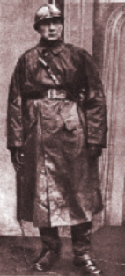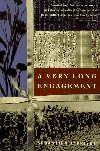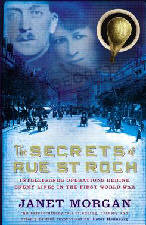
TRENCH REPORT: The Great War based film A Very Long Engagement has made a big splash amongst our readers. Consequently in this issue we present three major articles related to it -- including a review of the original novel -- and a number of photos from the period and the film. . . On January 29th a passenger who tried to take a World War One mortar shell in his car through the channel tunnel forced trains between Britain and France to be halted during rush hour. A British police spokesman today said no-one was in danger and they did not believe the incident was "terrorism related", but the tunnel had to be shut for 3 hours and the "item of munitions" cleared away. Stephen Hart, of Tunbridge Wells, Kent, was charged with possessing explosives without authority. . .Readers along the east coast will be interested in this WWI-era exhibit, "The Fatherless Children of France," in Dinand Library on the campus of the College of the Holy Cross, Worcester, Massachusetts. It includes autographs, manuscripts, photographs, and artwork from some of the greatest names in literature, art, politics, and the military of the WWI era. (link). . .Alone among the 19 regiments amalgamated in a recent reorganization of the British Army, the 6 Scottish regiments will be able to continue to use their old names, albeit as part of a single Royal Regiment of Scotland with a single tartan and cap badge. This apparently did not placate Annabelle Ewing of the Scottish Nationalist Party who was expelled from the Commons after denouncing Defence Secretary Geoff Hoon as "a back-stabbing coward" over the reorganization. Veterans groups were similarly enraged. . .The endless struggle over the Hawaiian War Memorial continues.
(link)

Memorable Event
|
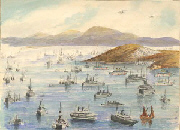
February 19, 1915
Initial Naval Assault
At the Dardanelles
Click on Image for More Information
|
|
New at the Websites of the Great War Society and Our Friends
Click on Title to Access
|
|
At Great War Society Sites
At the WFA-USA
|

| This Month's
Special Feature
The Great War's Most Famous Veteran
|
January 24th marked the 40th anniversary of the death of Sir Winston Churchill. Unarguably, he was the most notable and distinguished man to serve in the trenches of the First World War. Here are some articles about Sir Winston and his war activities.
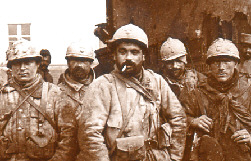
Not a Movie
French Poilus

I recently checked the Oxford English Dictionary and found two definitions for "Great
War": "(a) the French Revolutionary and Napoleonic Wars, 1793-1815; (b)
the war which began on 28 July 1914 with hostilities between Austria-
Hungary and Serbia, and ultimately involved the majority of the nations of
the world; it was suspended by armistice 11 Nov. 1918."
The first usage of "Great War" for (b) seems to have been in 1914, by Maclean's Magazine,
October Vol. 53, Number 1: "Some wars name themselves ... This is the Great War."
 What's the use of worrying?
What's the use of worrying?
Popular Song Lyric
|
Congratulations To The
Western Front Association
For 25 Years of Service
1980 - 2005 |

A Very Long Engagement
Book Review
By Len Shurtleff
A young, polio-crippled Frenchwoman, Mathilde Donnay, investigates the web of deception that shrouds the fate of five soldiers condemned for self-inflicted wounds. All five, including her fiancé, are reported dead. Refusing to believe this, the shrewd Mathilde hires a private detective, enlists the help of family and acquaintance and travels far and wide to unravel the cover-up and find her missing lover. Told at many levels and in many voices, the is at once a war novel, mystery and a love story.. The author uses many techniques including documents, flashbacks and brief, but brilliant character sketches to paint a vivid vision of wartime and postwar France.
Winner of the prestigious Prix Interallie in 1991, and a best-seller in France, this novel received well deserved praise in the United States when it was first published here in translation in 1996.
A Very Long Engagement, Sabastien Japrisot (translated from the French by Linda Coverdale), Farrar, Straus & Giroux, 2004, 327 pages, ISBN 0 31242 485 2, $14.00 paperback. Also on nine CDs (10 hours) from the same publisher; ISBN 1 59397 566 X, $39.95.
Sadly, we have another long roster of the fallen this month.
Kara Moser McCoy of Sebastopol, Calif. died January 17th age 106. Born in England, she lied about her age & volunteered as a nurse for the ANZAC Corps in 1914. Towards the end of the war she accompanied wounded from the Corps on their 6 week voyage home. After the war she worked in France with the Imperial War Graves Commission
Italy lost its last veteran from WWI January 25th when Carlo Orelli, popularly known as "the last infantryman," died at the age of 110, the government said Tuesday. Orelli fought as a foot-soldier in the trenches on the Carso Plateau which is now part of northeastern Italy.
As Italy's oldest survivor of the 1914-1918 war, he was a minor celebrity and a book based on his wartime diaries was published last year.
John Elliot, 105, onetime Pharmacist Mate aboard the Battleship USS Texas and until recently an avid golfer, passed away on January 20th at the veteran's home in Chula Vista, Calif. He has left us this wisdom: "Life is like golf...One minute you're great. The next minute you can't do anything. What are you going to do, [but] move on to the next shot."
Joseph E. Doan, Jr., 109, of Lansdowne, Pennsylvania, a retired architect and World War I veteran, died of heart failure 6 November 2004, at Delaware County Memorial Hospital. During the war Mr. Doan served as a sergeant in the Army Signal Corps, training mechanics and pilots at bases in the South. In 1919 he joined the newly formed American Legion and helped found the Lansdowne Post. He served as the post chaplain.
Ruben Law, Nevada's last remaining veteran of World War I and who was featured in our December issue, died on New Year's Day. He was 106. A transportation sergeant in the AEF, he was turned away when he tried to reenlist for the Second World War. This did not deter Mr. Law; he found his way into the Coast Guard Auxiliary and worked as the pilot of a patrol boat on the Mississippi. Towards the end of his life he contributed what should become an entry in the dictionary of great American quotes: "I've seen it all, I've heard it all and I've done it all. I just can't remember it all."
Professor Frank Vandiver, featured in our November 2004 issue, passed away in January. He was a most distinguished historian and educator, but I will always remember that in our chats he was always down to earth, friendly and generous with his time.
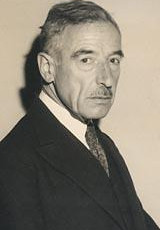
Who is this renowned surgeon who worked in both German and American military hospitals during the Great War.?
(email a correct answer for a prize)
GREAT WAR 2005 EVENT CALENDAR
|
WFA Pacific Coast Branch Spring Seminar
Victoria, British Columbia
March 11-13, 2005 (link)
|
WFA-USA East Coast Chapter Spring Seminar
Incl: Tour USS Olympia WWI Vet.
Philadelphia, Pa
March 19, 2005 (link)
|
WFA-USA Semi-Annual Seminar & Tour
Openings Now Available
Somme, Arras, Marne, Ch. Thierry
April 4-16, 2005 (link)
|
Great War Society 14th National Seminar
America & the Great War, 1914-20
Furama Hotel, Los Angeles
April 22-24, 2005 (link)
|
WFA New England - New York Spring Seminar
FDR Presidential Library,
Hyde Park, NY
June 11, 2005 (link)
|
WFA-USA 16th Annual National Seminar
Virginia Military Museum
Newport News, Virginia
September 23-25, 2005 (link)
|
Send additions/corrections:
Email Response
|
|
|
Page Two
|
 |
The Secrets of Rue St. Roche
Intelligence Operations Behind Enemy Lines in WWI
By David Heal from Luxembourg
|
This is a true adventure that makes James Bond look like an amateur. It is chronicled in possibly the most amazing book about World War One to have been published over the last few years. It reveals that not only did the Allies know that the 1918 Ludendorff Offensive was to take place (although they did not know the date), they also had a virtually complete Order of battle for the German forces.
Apart from that, no one in their right mind would have their hero floating over the trenches in a hydrogen balloon to get to Luxembourg from France and lend his assistance in enciphering the information. No fiction would have their heroine smuggling herself from France through Switzerland and into Germany en route to Luxembourg, and no fiction author could come up with the cipher system that allowed detailed information on troop movements to be sent to the Allies within days. Few fiction authors would dare to suggest that censors would not look carefully at newspapers so as not to delay the news. And yet, all this happened. This book gives it in full detail.
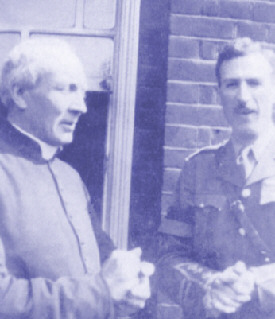
Capt. Bruce and Priest Who Assisted the Ring
The story of how this was discovered begins on a fine Easter morning in 1995 when Janet Morgan and her husband Robert Bruce finally discovered the key to open a chest belonging to Robert's father, Major George Bruce that had sat unopened in the attic of their home for almost thirty years. They knew that the chest held information about a secret mission run by Major Bruce, as Robert had been allowed to see the contents briefly for an hour in the mid-1960s. What it turned out to be, however, was the only complete record of an Allied espionage operation to survive from the First World War.
They discovered that the team communicated their vital intelligence in coded letter written ostensibly between the members of a respectable Parisian family and in coded newspaper editorials. After the War, Captain Bruce ignored orders to burn his records and hid them in the chest in his house in Scotland. The correspondence, along with a host of other fascinating documents, maps and photographs were all preserved.
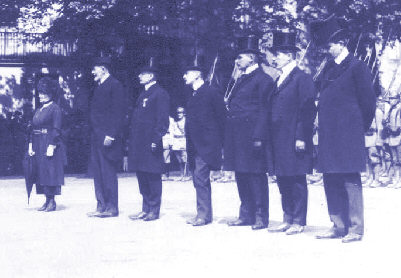
Members of the Ring Receiving Decorations in Luxembourg City
Since their discovery in 1995 Janet Morgan and her husband have travelled throughout Europe finding descendants of members of the espionage ring and have spent many hours deciphering coded letters and secret reports, examining maps, timetables, moonlight diagrams and methods of escaping from prison camps and learning about railways, espionage, pigeons and ballooning. My part in this was that I started researching the story in 1983 when writing for a magazine in Luxembourg, but without any really accurate information to start from - except for one or two names. I eventually got to the name Bruce and found their address just weeks after the opening of the chest!
|
 |
Jean-Pierre Jeunot's
A Very Long Engagement
By Andrew Melomet |
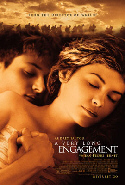
Manech & Mathilde
In Happier Days |
In 1917, five French soldiers are court-martialed and are found guilty of self-mutilation. In punishment they are sent over the top into no-man's land. Following World War I, polio-crippled Mathilde (Audrey Tautou) stubbornly refuses to believe that her lover Manech (Gaspard Ulliel) died on the battlefield. She sets off on a quest to find him.
This is an authentic romantic epic filled with gut wrenching scenes of combat and all the graphic violence possible through special effects and CGI. Postwar Paris and rural France are beautifully recreated. And since, it's French there's a heaping dose of graphic sex as well. Mathilde is helped in her investigation by an inept detective named Pire (Ticky Holgado). (Pire means "worse" in French.) And there's another woman also searching out survivors from the battlefield, Tina Lombardi (Marion Cotillard) but she's on a mission of vengeance. She's the dark doppelganger of sweet but slightly monomaniacal Mathilde. This entertaining subplot is done as homage to the French serial thrillers such as Les Vampires that were popular during The Great War.
Mathilde's search follows up on all possible leads and eventually the back stories of each of the doomed five is filled in through many flashbacks. Now, ever since Saving Private Ryan, war films have been trying to out do each other in depicting the graphic violence of combat. But, sensitive souls who close their eyes during these moments in A Very Long Engagement will miss important clues vital to understanding the denouement. Finally, it's all sorted out. Although I'm still not sure who exchanged identities with whom in their desperate efforts to survive.
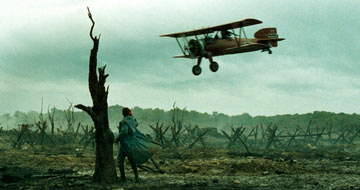
Scene from the Film
A Very Long Engagement, directed by Jean-Pierre Jeunot, from a screenplay by Jeaunot and Guilliame Laurant, based on a novel by Sébastien Japrisot was disqualified as the Best Foreign-Language Picture nominee for France. However, it is nominated for both its Cinematography by Bruno Delbonnel and Art Direction by Aline Bonetto.
While this is certain to be released on DVD later in the year, I would certainly recommend seeing it on the big screen sooner rather than later. It is currently in limited release and has grossed less than $5 million dollars in the US Market. In other words, it may not have a very long engagement theatrically. (Groan).
Andrew Melomet, Proprietor of Andy's Nickelodeon will answer your Great War film or video inquiry. Just click HERE.
|
|
From Tony Langley's War in a Different Light
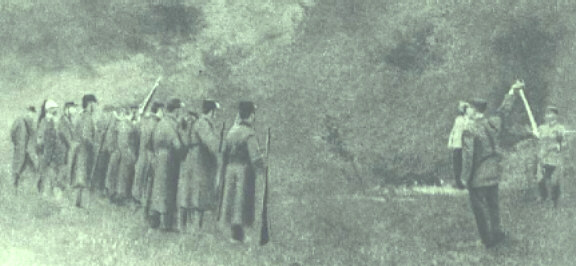
Captaine Estève Faces the Firing Squad For Refusing Frontline Service
Unlike an Earlier Trip-Wire Photo of an Execution Hoax, This One Is Authentic.
Click Here to Visit War in a Different Light
|
 |
Post Your World War I Stumper Here
|
Member and regular contributor, Col. Bill Anderson, USMC lost his grandmother last November. Teresa Caroline Farnell Rosson was born on 18 September 1900 in Mobile, Alabama. Her extraordinary life
spanned three centuries. Bill subsequently inherited the uniforms of his grandfather, Lt. W.M. Rosson who was a veteran of the 305th Infantry, 77th Division of the AEF. Other than the WWI Victory Medal Ribbon [upper left], we have been unable to identify the other ribbons Lt. Rosson displayed.

If you can help with this, please contact Bill Anderson directly with your information. (email)
|
 |
European Responses to A Very Long Engagement
By Tony Langley from Antwerp
|
Here in Europe A Very Long Engagement was indeed universally acclaimed and got very good reviews. I too found the characters at first a bit hard to follow, especially with their odd colloquial french (nick)names. I tried following French only, but had to resort to the Dutch subtitles I'm ashamed to admit. But other than that I myself have no complaints about the movie or story, nor did the critics by and large (for what that's worth). The reconstructions of 1920s Paris was fabulous and charming and the battlefield scenes were first rate.
Though I do have to agree upon reflection, that there was a somewhat
fairy-tale like atmosphere to the film. It was not, for instance a movie of military realism like 'Private Ryan', 'Band of Brothers' or even 'Der Untergang'. It was something more in the line of a love quest set during wartime, peopled with characters of very clear moral worth - either they are trustworthy and good or they are reprehensible and despicable.
I went through a few on-line archives of Dutch language newspapers. One
article, by a critic who obviously didn't enjoy the film very much gave the following reasons. It was, in his considered and weighty opinion, a typical Hollywood production and story. Why ? It has a happy-ending, the action and events are somewhat unbelievable and the characters are stereotyped oddballs, not people one would normally encounter in everyday life. They are all a bit intense, sometimes comical to a degree or else dramatically tragic and display characteristics more apt for a theater-piece or movie.
Personally I think the critic is more of a sourpuss than anything else, one of those types who simply hates Hollywood or American culture, but he does have a point when he says that the characters, while very memorable and colorful, are not quite authentic either. That is, you really wouldn't encounter or have encountered people like that in real life. Not now and not in 1920 either. Not even in France. The story has something of a fairy-tale like atmosphere about it, which, says the critic, is not unreasonable, given the type of director that Jean-Pierre Jeunet is and given his previous movies, especially 'Amalie Poulain' (a movie that will probably forever define his career).

Manech |
But you have to appreciate the irony of a European film critic, more or less reproaching a completely French production (except for the funding) for being too Hollywoodish!
The director of the movie, Jean-Pierre Jeunot, is a Great War enthusiast, reading about the war is one of his passions. I believe he said something about neglecting his sunbathing (and his girlfriend) when on vacation to spend time reading on the Great War. Many of the actors in Long Engagement, were also actors in Jeunot's previous hit 'Amalie Poulain'. And since 'Amalie' was a strange, magical sort of comedy, many critics/movie buffs thought those actors would turn out to be misplaced in a war-movie. Instead they give wonderful performances.
Some small points: The movie is nicknamed 'Amalie s'en va-t-en Guerre' (Amalie Goes to War) here in France and Belgium, among those who consider themselves movie buffs. It's an acknowledgment to a (very awful) Bridget Bardot movie from the 1970s called 'Babette s'en va-t-en Guerre'. One point of criticism I heard from military buffs - some of the trenches were dug too wide. I suppose that's correct but this was only a minor point and probably necessary for optical/ technical reasons.
A number of French patriots dislike the movie. They seem to confuse the historical setting with an intention to portray the war. Rather it's a love story in essence, not a war-story and maybe therefore
follows different storytelling conventions. How did their complaining manifest itself? Just word of mouth mostly, opinions passed along to friends and such; and possibly reviews and letters to the editor in newspapers and magazines. In any case their protest goes something along these lines: Yes, soldiers were executed for self-mutilation, but if so, they were guilty as charged and suffered the proscribed penalty. Army courts-martial were not as arbitrary and summary as portrayed in the movie and they would certainly never have punished the soldiers as shown in the movie, throwing them into no-man's land, such things were simply not done. So by showing this lie in a movie, it is defamation of the army and a disgrace to the honor of France.
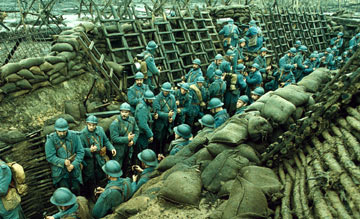
Preparing for an Attack
Another more telling critique comes from what you would call French
ultra-patriots - they object to the insinuation that soldiers were treated so harshly during the Great War. Treatments and punishments such as were shown were not done according to their views. Now THAT is I would think a rather silly and naive view, but I'm just giving it for what it's worth. I'm certain that common French soldiers were
often treated like shit and worse.
|
 |
Discovering Another Great War Monument: In Portugal
By Christina Holstein
|
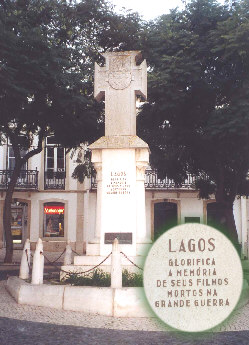 |
On December 31st, I was visiting Lagos in the SW corner of Portugal. It is close to the town of Sagres, home of the famous Infante Don Henrique of Portugal, known as Prince Henry the Navigator, whose encouragement of exploration led to the great voyages of discovery in the 15th and
16th centuries. Even so distant from the Western Front, I found a monument honoring the fallen of the Great War.
|
|
| The following are thanked for their contributions to this issue of the Trip Wire: Christina Holstein, Lannie Liggera, Phyllis Pettyjohn and the WFA-USA Field Memo, Jim Broshot, David Heal, Sam Harper, Joaquin Espinoza, Tom Olson, Tony Langley, Andy Melomet, Len Shurtleff, Bill Anderson, Agnes Peterson, Robert Rudolph and Susan Neeson. Forgive me those whom I may have forgotten. Until next month, your editor, Mike Hanlon. |
|













